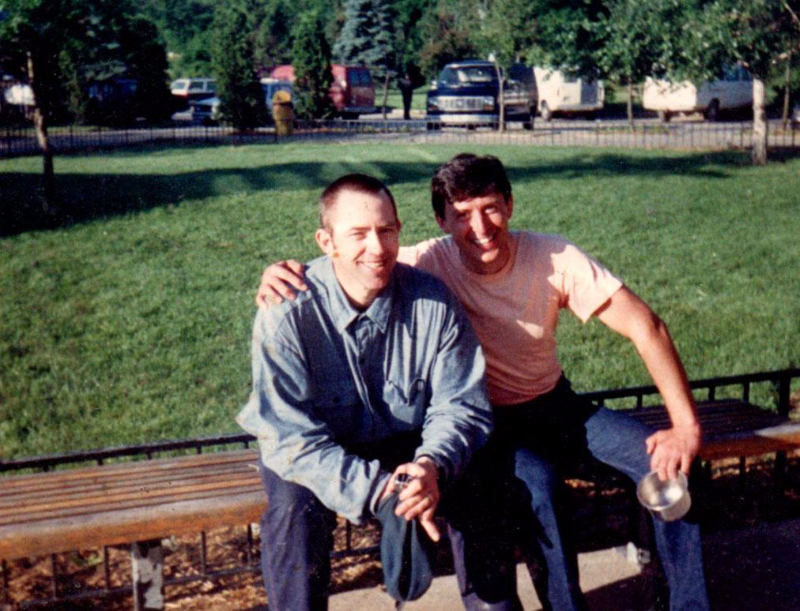
Janmastami dasa and Tulsi dasa on a bench near the entrance of the Radha-Vrindaban Chandra Temple of Understanding at New Vrindaban (c. 1985).
| Killing for Krishna The Danger of Deranged Devotion a book by Henry Doktorski Publication date: January 1, 2018. © by Henry Doktorski |

Janmastami and Tulsi
from Chapter 10: The Cast of CharactersJanmastami dasa (John Anthony Sinkowski) (b. July 22, 1947) had a gruff exterior, but his heart was full of love/fanaticism for his “spiritual master.” He was a tough no-nonsense fellow, but could also be kind. I first met him in 1979 when I briefly taught at the Nandagram gurukula. I remember he was hauling wood for the school’s furnace. Seeing me—and perhaps thinking I was a greenhorn unfamiliar with the intricacies of country living—he stopped his labor and gave me some advice. He showed me some poison ivy growing near the building. “See that?” he said. “In the spring, if you pick one of the young leaves and eat it, and continue to do so every day, your body will gradually build up a tolerance for the poison and you’ll be immune for the rest of the summer.”
Years later, I once worked for Janmastami in Washington D. C. helping to sell flowers at sidewalk tables during a Mother’s Day marathon. His shop, in a poor and run-down neighborhood where carjackings and drive-by shootings were not unknown, catered not to physical comforts, but existed only to maximize service to guru and Krishna. He lived very simply. I don’t even think he and his wife had a bed. I remember seeing his kid in a playpen practically buried by enormous stacks of boxes of roses; it was so cramped and crowded and filthy. The place had no material amenities, but the rent was cheap, and he willingly performed those austerities to increase profits for New Vrindaban.
Gaura-Shakti (Gregory Carlson), an electrician who served in the community’s construction department and who later became a member of the surveillance team which tracked Sulochan’s movements, thought Janmastami was “basically a good person.” He remembered, “I thought his personality was a little bit rough, but basically he was a good person. He would rise very early in the morning and always came to our morning religious services and he would work hard all day long. He would not take anything for himself. He never asked for any money for his labor. . . . Although his personality was a little rough and sometimes he was a little overly-critical and hard to get along with . . . basically he was a good person.”
According to some, Janmastami was a humble and austere brahmacari. The gurukula boy, Hari-Venu (Geraldo Altamirano) remembered, “Janmastami worked for Jayamurari in plumbing. He maintained the boilers in the community. He worked very hard and never asked anything for himself. When he lived at Old Nandagram, he fed himself by eating the remnants from the gurukula boys. When we were done eating, we’d empty the leftovers from our plates into a bucket outside. It looked like slop. Janmastami got his food from that bucket. He accepted the remnants of the gurukula boys in the mood of honoring maha-prasadam remnants from great devotees. He was a humble and austere brahmacari. He never kept anything for himself. Yes, sometimes he could be a scary guy, but I liked him.”
Janmastami remained at New Vrindaban until 1994, when Kirtanananda asked him to leave. Janmastami served as a hit man; he searched for Sulochan in California in January 1986. He carried a handgun and a vial of cyanide in case he found an opportunity to “neutralize” his quarry. Janmastami never found him, because at that time, Sulochan was staying with his parents in Royal Oak, Michigan, a suburb of Detroit. Later, in February 1986, when Tirtha came to California to hunt Sulochan, Janmastami served as Tirtha’s partner in crime. The two networked with California ksatriyas, and traveled to abandoned mine shafts in the Mojave Desert in the company of the Los Angeles ISKCON head of security, Jeffrey Breier (Krishna-Katha) and his assistant Mahamantra (David Fuller), where they thought they might dispose of Sulochan’s body after the murder.
Although Janmastami contributed hundreds of thousands of dollars to New Vrindaban in the 1980s and 1990s from profits from his flower-selling businesses in Philadelphia, and later in Washington D. C., since 1998 he has been unemployed and homeless and living with friends.
In this photo, Janmastami is sitting on a bench near the entrance of the Radha-Vrindaban Chandra Temple of Understanding (built in 1983), with Tulsi dasa (Richard Allen “Dick” Dezio), the director of New Vrindaban Public Affairs who formerly served as an Instructor of Economics at West Virginia University at Parkersburg. He came to live at New Vrindaban around 1985 and assisted in public relations and legal affairs. He served as the primary community spokesman in 1985 and 1986. In the late 1980s, Dezio studied law at West Virginia University Morgantown and, in 1990, became a West Virginia licensed attorney. Today, Richard Dezio, P. C., has an estate planning practice in Alexandria, Virginia.
Back to: Killing for Krishna Homepage